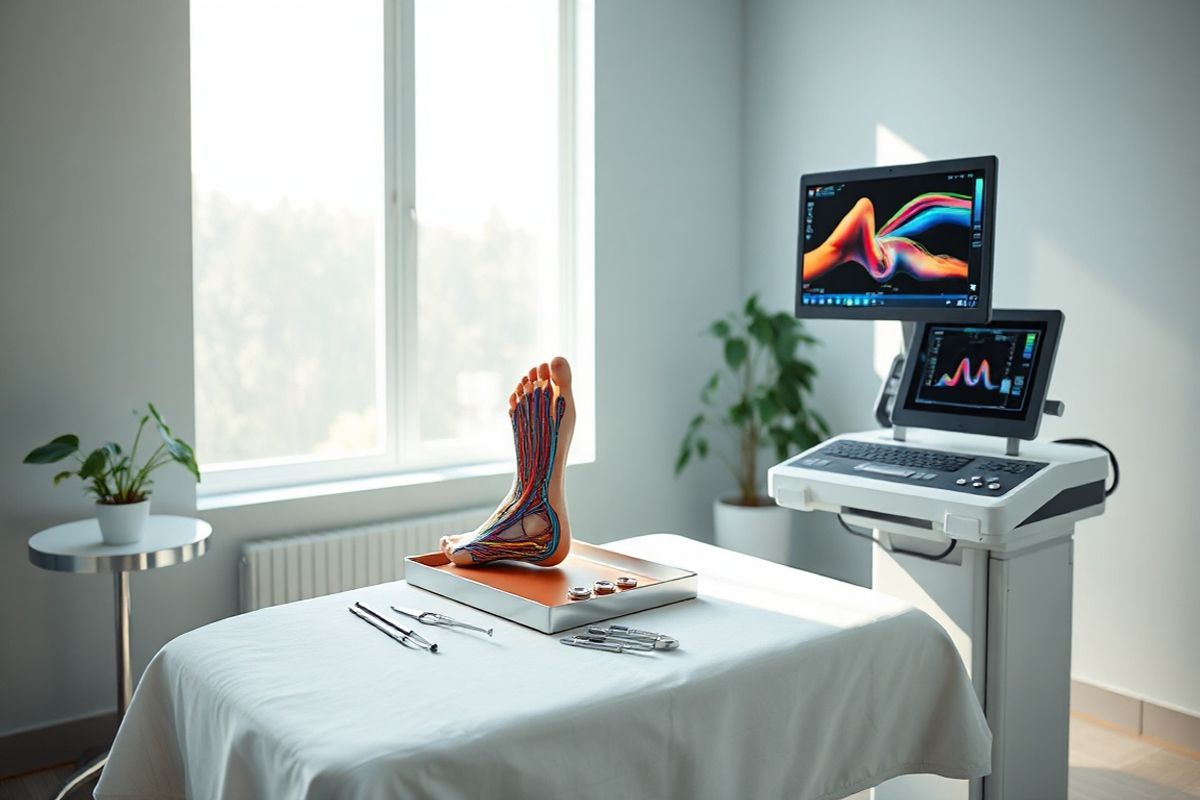Table of Contents
The Basics of Plantar Vein Thrombosis: What You Need to Know

Plantar vein thrombosis (PVT) is an uncommon but significant condition that can lead to discomfort and complications in foot health. It involves the formation of a thrombus, or blood clot, within the plantar veins of the foot, which can be caused by various factors including trauma, prolonged immobility, and underlying health conditions. Typically, the deep plantar veins consist of lateral and medial plantar veins, which accompany the respective arteries and play a crucial role in venous drainage and circulation within the foot. When these veins become thrombosed, it can disrupt normal blood flow, leading to pain and swelling, and potentially resulting in more severe complications such as pulmonary embolism if the clot dislodges (The Chelsea Clinic, n.d.).
The anatomy of the plantar veins is integral to understanding plantar vein thrombosis. The lateral and medial plantar veins originate from the first intermetatarsal space and drain into the posterior tibial vein at the medial malleolus. The lateral plantar veins are particularly susceptible to thrombosis due to their anatomical positioning and the dynamics of blood flow in the foot. This anatomical knowledge is essential for health practitioners diagnosing and treating PVT effectively.
Identifying Symptoms of Plantar Vein Thrombosis: Recognizing the Signs
The symptoms of plantar vein thrombosis can vary widely, ranging from mild discomfort to severe pain that significantly impacts daily activities. Common symptoms include:
- Localized Pain: This is often described as a dull ache or sharp pain in the heel or arch of the foot, which may worsen with activity.
- Swelling: The affected area may appear swollen, and the skin may feel warm to the touch.
- Color Changes: In some cases, the skin over the affected vein may exhibit a reddish or bluish tint.
- Heaviness or Fullness: Many patients report a sensation of heaviness in the foot, which can make walking uncomfortable.
Less common symptoms might include numbness or tingling in the foot, which can further complicate the clinical picture. These symptoms can severely affect one’s quality of life, limiting mobility and participation in daily activities or exercise (RadiologyInfo, n.d.).
The impact of these symptoms is profound, as they can lead to altered gait patterns, increased risk of falls, and overall decreased functionality in daily life. Consequently, recognizing these signs early is crucial for effective management and treatment of the condition.
Diagnostic Approaches for Plantar Vein Thrombosis: How is it Diagnosed?

Diagnosing plantar vein thrombosis requires a thorough clinical evaluation and appropriate imaging studies. Initial assessments typically include a detailed medical history and physical examination to identify symptoms and any potential risk factors. The following diagnostic tools are commonly employed:
-
Doppler Ultrasound: This is often the first imaging modality used, as it can visualize blood flow in the veins and detect thrombi. It characteristically shows hypoechoic, noncompressible vessels with no luminal blood flow (Isolated Plantar Vein Thrombosis Resembling a Corn with a Bruise, 2019).
-
Magnetic Resonance Imaging (MRI): MRI may be preferred for cases where Doppler ultrasound results are inconclusive, especially in patients with persistent pain or other complicating factors. MRI findings for PVT typically reveal intraluminal filling defects in the plantar veins along with perivenular enhancement (RadiologyInfo, n.d.).
-
Venography: While less frequently used today due to the non-invasive nature of ultrasound and MRI, venography can still provide definitive evidence of thrombosis if other imaging modalities are inconclusive.
Proper diagnosis is critical to differentiate plantar vein thrombosis from other foot-related issues such as plantar fasciitis, calluses, or warts, which can present similarly but require different treatment approaches (Isolated Plantar Vein Thrombosis Resembling a Corn with a Bruise, 2019).
Treatment Options for Plantar Vein Thrombosis: From Medication to Surgery
Treatment for plantar vein thrombosis varies depending on the severity of the condition, underlying causes, and individual patient factors. Here are the primary treatment modalities:
Medications
-
Anticoagulants: Blood thinners such as warfarin or novel oral anticoagulants are often prescribed to prevent the thrombus from enlarging and to reduce the risk of further clot formation. While anticoagulants do not dissolve existing clots, they allow the body to gradually break them down over time (Treating Pulmonary Embolism, n.d.).
-
Analgesics: Non-steroidal anti-inflammatory drugs (NSAIDs) can help manage pain and inflammation associated with the condition.
Lifestyle Modifications
-
Activity Modification: Patients are advised to avoid activities that exacerbate symptoms, particularly those that involve prolonged standing or heavy lifting.
-
Compression Therapy: Wearing compression stockings can help improve venous return and reduce swelling in the affected foot.
Surgical Intervention
In cases where conservative management is ineffective, or if there is a significant risk of complications, surgical options may be considered. Surgical thrombectomy is a procedure that can be performed to remove the thrombus directly from the affected vein. This is typically reserved for severe cases where there is significant pain or risk of complications such as pulmonary embolism (Surgical Thrombectomy, n.d.).
Deciding on the appropriate treatment plan should be done collaboratively between the patient and healthcare provider, taking into account the patient’s overall health, preferences, and specific circumstances.
Preventing Plantar Vein Thrombosis: Tips for Foot Health and Well-being
Preventive measures play a crucial role in managing plantar vein thrombosis, especially for individuals at higher risk. Here are some actionable steps to reduce the likelihood of developing this condition:
-
Stay Active: Engage in regular physical activity to promote circulation. If you have a sedentary job, make a conscious effort to stand up and move around periodically.
-
Footwear Choices: Opt for supportive, well-fitted shoes that do not compress the foot and provide adequate arch support. Avoid high heels and shoes with inadequate cushioning.
-
Hydration: Adequate hydration helps maintain blood viscosity and prevent clot formation.
-
Weight Management: Maintaining a healthy weight can reduce pressure on the plantar veins and decrease the risk of thrombosis.
-
Monitor Symptoms: Be vigilant about any changes in foot health, and seek medical advice promptly if you experience symptoms suggestive of PVT.
Early intervention and education about foot care are essential in preventing the development of plantar vein thrombosis. Regular check-ups with healthcare providers can also aid in early detection of potential issues.
FAQ
What is plantar vein thrombosis?
Plantar vein thrombosis is the formation of a blood clot in the veins of the foot, which can lead to pain, swelling, and complications. It is a rare condition often confused with other foot ailments.
What are the symptoms?
Common symptoms include localized pain, swelling, color changes in the skin, and a feeling of heaviness in the foot.
How is it diagnosed?
Diagnosis typically involves a physical examination and imaging studies such as Doppler ultrasound or MRI to visualize the thrombosis.
What treatments are available?
Treatment options include anticoagulant medications, lifestyle modifications, and in severe cases, surgical intervention such as thrombectomy.
How can I prevent plantar vein thrombosis?
Prevention strategies include staying active, choosing appropriate footwear, maintaining hydration, managing weight, and monitoring for any concerning symptoms.
References
-
Isolated Plantar Vein Thrombosis Resembling a Corn with a Bruise. Retrieved from https://anndermatol.org/DOIx.php?id=10.5021/ad.2019.31.1.66
-
Treating and Managing Pulmonary Embolism. Retrieved from https://www.lung.org/lung-health-diseases/lung-disease-lookup/pulmonary-embolism/treating-and-managing
-
Surgical Thrombectomy. Retrieved from https://www.hopkinsmedicine.org/health/treatment-tests-and-therapies/surgical-thrombectomy
-
Blood Clots. Retrieved from https://www.radiologyinfo.org/en/info/bloodclot
-
The Chelsea Clinic. Plantar Vein Thrombosis. Retrieved from https://www.thechelseaclinic.uk/plantar-vein-thrombosis/











